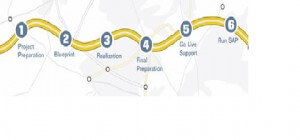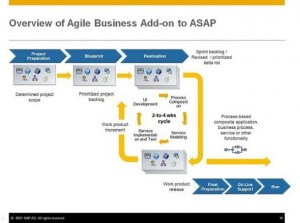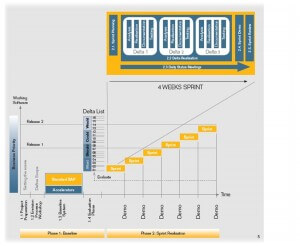This website uses cookies. By continuing to browse the site, you are agreeing to our use of cookies
SAP Implementation Using Agile Methodology
ABSTRACT
AGILE: CONTINUALLY REACTING TO THE REQUIREMENTS OF YOUR BUSINESS
The success of your SAP solution is to a large degree determined by the speed and the effectiveness of the software to add value to your organization. Agile: a new, practical implementation methodology that allows you to implement operating functionality in short iterative cycles. Starting with the most important one, enabling you to generate faster results, gain immediate insight into the value, increase the flexibility of the implementation and improve progress monitoring.
Expectation of Customers
Respond faster to market demands. That is what customers and both internal and external stake holders expect. This poses high demands on the set up and flexibility of your IT landscape. But how does this speed translate into the implementation of new projects? Can the software give added value faster and optimally meet the requirements of the end user?
To respond to these requirements a new, practical, hands-on implementation methodology is Agile. This iterative methodology, called Agile, is based on the ‘lean’ principles for software development and uses elements from ‘scrum’ as implementation methodology.
The focus is on simplicity. At a very early stage you gain a good picture of your system on the basis of standard SAP software, the baseline configuration. Then new functionalities for your solution are delivered step by step in so-called ‘sprints’.
Advantages at a glace
Faster results
- Step by step delivery of software via ‘sprints’ of 4 weeks
- Delivery of software based on the priorities of the customer
- Costs and value per sprint clearly shown
- More transparency
- Operating components delivered for SAP software are a benchmark for progress
- Checkpoints (demos) to check requirements and results
- Risks are quickly identified and therefore manageable
- Daily meetings of the implementation team
- Business is permanently and from early on involved in the process
- Increased flexibility
- Can respond to changes per ‘sprint’
- Continuous configuration and delivery of software
- Can take account of insight into the business
Traditional ASAP Methodology

VS
ASAP with Agile Methodology

Background to Agile
The word Agile means to move fast, lightly and easily. Agile expects that during the implementation users discover the possibilities of the system, adjust demands and requirements, and want to profit immediately from the advantages. The aim of Agile is to deliver operating functionality of the software as fast as possible, starting with the components that are most important for your business. Being able to demonstrate software in operation quickly creates understanding and enthusiasm. Certainly for users that aspect is more important than the availability of detailed documentation.
“If I can’t picture it, I can’t understand it” – Albert Einstein
Another core element is cooperation. Individual interests and interaction are more important than agreements about processes and tools. The use of scrum methodology guarantees continuous communication and coordination between the business and IT. This prevents misunderstandings and ensures added value at an early stage. The business is responsible for answering the ‘what’ questions and assigns priorities. The SAP implementation team then determines ‘how’ this can be done best and makes an estimate of the efforts required to do this.
Advantages in detail:
Faster results
The implementation starts with a firm foundation based on standard SAP software. In small iterations, so-called sprints, the implementation team continually delivers new functionalities. In this way your new solution can deliver immediate profit at an early stage. You also prevent time and money being spent on functionality that you do not require.
Improved progress monitoring & coordination
During a typical agile implementation, daily meetings are held with the team and the interested parties. These ‘Scrum Meetings’ keep you in constant contact with the project and allow you to follow the progress closely. Various checkpoints (demos) ensure that the SAP system links in with your requirements. After each clearly defined sprint, and the working software it delivers, it is clear what progress has been made and what still needs to be done. In this way risks and problems are identified at an early stage of the project.
More flexibility during implementation
The agile approach enables you to react decisively and effectively to change. In contrast to other methods there is no blueprint that serves as the basis for the entire implementation. Agile is based on the assumption that requirements will change with time. Therefore changes can still be proposed and effected during the implementation.
Agile implementation phases
The Agile implementation consists of two phases: Baseline and Sprint Realization
Phase 1: Baseline
In this phase four steps are taken with the end result being an overview of the additional, prioritized requirements and wishes with respect to the basic configuration supplied by standard SAP software. It starts with the Project Preparation (1.1) (see following illustration) in which elements such as roles & responsibilities, documentation standards and hardware requirements are discussed. Then all operating processes and process dependent conditions such as master data, conversions, security & authorizations, and interfaces are carefully identified during the ‘Envision Process Workshops (1.2)’ step. Business and IT work closely together for this. This determines the scope of the project. On the basis of these outcomes, this will be translated into a solid foundation for the entire project, a Functioning Baseline System (1.3). This is based on standard SAP software. The SAP implementation team first makes an inventory of whether project accelerators such as SAP best practices and Fast track services can be used.
Finally the Evaluation Phase (1.4) takes place. In this phase the business determines the priority of the additional requirements and functionalities, the so-called ‘delta list’, in order of ‘business value’. In this way you differentiate between the ‘Nice-to-haves’ and the ‘must-haves’. The implementation team then estimates the effort that will be required to realize this and determines the planning of the sprints for the system components to be supplied.
At the end of this phase you will be able to see:
- The degree to which your processes and requirements can be realized using standard SAP software.
- What the business thinks about the first results.
- The functionalities, wishes and priorities for executing the process optimally that is missing.
- An initial estimate of the effort from the team, which will be the basis for a release plan: what can be supplied in which sprint?

Conditions for success
Agile is based on a short implementation cycle and high speed. This requires constant feedback and attention from the ‘Process Owner(s)’ who represent the business stakeholders. Important conditions for success are therefore the involvement from the business, a clear picture of the requirements and priorities for the project and good technological preparation. If the correct setup is not yet present then the project focuses on this first.
Involvement of business via ‘Process Owner(s)’
Decision-making and internal coordination and communication with the various business stakeholders concerning the requirements and priorities; these are the most important tasks of a Process Owner (PO). In this way the PO represents the customer and the requirements and links these to the implementation team. The PO also administers the Delta List. This is a list of the differences between the possibilities of the baseline system and the processes and functionalities required from the point of view of the business. With this the PO gives the implementation team clear priorities for the various Delta requirements. Finally it is crucial that the availability of the PO is frequent enough during the project. If there are several Process Owners, we ask for one chief PO for mutual benefit who can take a final decision if interests differ.
Good inventories of requirements and priorities for the project
What are the operating processes and functionalities desired in the new system? The clearer this is, the better the scope of the project can be defined. Especially, if the priorities are established on the basis of the most added value for the organization.
Options
Each project has its own characteristics. In addition to ASAP, the linear implementation methodology of SAP with more than 30 years embedded implementation experience; there is now the option of Agile. You must make a well-informed choice here. The degrees of flexibility desired during the implementation and the necessity for continuous coordination with the business are important criteria here. As also are the requirements imposed on documentation and organizational change management.
Related Blogs

Why AI and Automated Workday Testing Will Be Essential for Businesses in 2025
- Enterprise Platform Services

Workday Post-Go-Live Testing: Why It’s Critical for System Stability
- Enterprise Platform Services

SAP S/4HANA Migration Strategy: Brownfield vs. Greenfield vs. Hybrid Approach
- Enterprise Platform Services

S/4HANA Implementation Best Practices: Lessons from Enterprise Deployments
- Enterprise Platform Services

SAP Databricks: Transforming ERP Challenges into Opportunities
- Enterprise Platform Services

7 Reasons for Shifting Your Legacy ERP to the Cloud
- Enterprise Platform Services

Maximizing Business Growth Through RISE with SAP
- Enterprise Platform Services

5 Key Phases in Your SAP Implementation Journey
- Enterprise Platform Services

Ready to Pursue Opportunity?
Every outcome starts with a conversation









